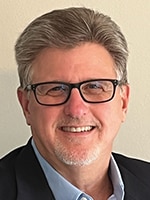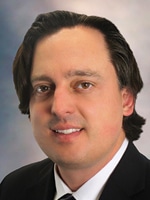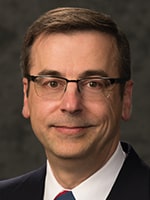February 2023—As this year’s guide to anatomic pathology computer systems was taking shape, CAP TODAY publisher Bob McGonnagle met online with representatives of five companies and with John Sinard, MD, PhD, of Yale University School of Medicine. They talked about the cloud, CPT codes, training of pathology informaticians, and artificial intelligence, for which the time frame in pathology is far longer than it’s been portrayed, in Dr. Sinard’s view.
“It will start to impact the careers of some of our trainees, but it’s probably a 10- to 20-year time frame before it plays a major role,” he said.
The view of Joe Nollar of Xifin: “Speculation that AI will someday replace pathologists is completely overblown,” though it will help to triage cases and mitigate risk.
Their full conversation, which took place Dec. 20, 2022, follows.
Last year we talked about Oracle’s acquisition of Cerner, which led to a discussion about the cloud, its advantages, and how it seems to have entered into a prominent point of desire for customers and vendors alike. Joe Nollar, what has changed in the past year? Have you seen this deepening? And have you seen evidence from the Oracle-Cerner combination that’s of importance to the anatomic pathology marketplace?
Joe Nollar, associate vice president of product development, Xifin: The merger is an opportunity for Cerner to leverage Oracle assets to a great benefit. But it’s a long process to bring the entities together in a meaningful way, so we haven’t fully seen its impact. What I’ve seen pick up steam is people on older platforms migrating to cloud-based solutions from traditional, locally hosted environments. There’s a lot of activity in the AP sector moving from traditional on-premises systems to the cloud.
Chad Meyers, can you comment on where the Oracle-Cerner combination and the cloud stand a year later?
Chad Meyers, MBA, vice president/service line manager, global anatomic, molecular, and digital pathology solutions, Clinisys: To Joe’s point, it’s going to take time, and Cerner still has a large focus on the EHR versus the laboratory information systems space where Cerner started. They’re working to bring those two companies together, especially with their Veterans Affairs contracts and others.
We’re seeing more health systems’ chief information officers looking at their overall cloud strategy, doing five-year planning, and in some cases working with third-party partners like Accenture to plan how to move their IT assets to the cloud, including the EHR and other systems. The Cerner-Oracle deal combined with Epic’s release of Hyperdrive, a Web-based client that can better
support a cloud-hosted version of Epic, is a catalyst for them to look at their overall footprint and say, If I can move my EHR to the cloud, I should plan to move the rest of my ancillary systems to the cloud.
John Sinard, what do you make of the movement to the cloud and the future of Cerner, which you’ve had a bird’s-eye view of for a long time?
John Sinard, MD, PhD, professor of pathology and of ophthalmology and visual science; vice chair and director of clinical operations, pathology; and medical director, pathology informatics, Yale University School of Medicine: Many health care organizations are still uneasy with the cloud. There’s a greater emphasis on security, and the larger, more conservative institutions have been reluctant to put their data there. For the places that are moving into digital whole slide imaging, there are huge storage needs for the volume of data. Institutions are finding that the cloud is a cheaper solution than bringing the storage in-house. It’s starting to get a lot of places, including my own institution, to look more seriously at cloud-based solutions, initially for storage and then potentially for applications. Trusting a cloud solution for applications will still take effort for some institutions that recognize the importance of uptime and the risks to their missions of downtime.
Suren Avunjian, give us your opinion about what’s going on a year after the big move to the cloud and Oracle’s acquisition of Cerner.
Suren Avunjian, founder and chief executive officer, LigoLab Information Systems: I agree it will take them time to fully shift to the cloud. I also agree with John—the larger laboratories we work with like to have the data close to them. Smaller organizations are more apt to have their data in the cloud because there is a significant up-front capital expenditure to build out a data center or server room and hire IT professionals to manage it. That would not make sense for smaller laboratories. The cloud solution breaks this cost down to a small monthly fee that is easier to absorb. Larger organizations continue to ask for an environment that’s deployed within their internal cloud. We need to provide the flexibility of both options.

McKinney
Keith McKinney, what are your thoughts?
Keith McKinney, vice president of sales, Orchard Software: Our client base is rapidly accepting the move to the cloud. One factor is the shortage of hardware—some clients are due for hardware upgrades and can’t get the needed hardware. It’s driving people to the cloud to keep their systems secure and maintained to minimize situations related to hardware failures. We’re also seeing large and small clients move to the cloud because of the risks of their systems being hacked and the associated liabilities.
Is this also reflective of shortages around IT and other staff who need to service these systems?
Keith McKinney (Orchard): In health care organizations, yes. People are even contracting our support department for more services because their ability to staff and take care of their information systems is limited at this time.
Ed Youssef, NovoPath has a big initiative to put a version on the cloud, but is there also an economic squeeze that is leading people to think the cloud is a great solution for a stressed health care system?
Ed Youssef, chief strategy officer, NovoPath: Yes. We’re seeing a huge shift toward the cloud especially in the last couple of years. For the larger organizations, maintaining on-premises environments is more expensive than maintaining a cloud environment. While smaller labs may be able to utilize the minimum required hardware on-premises that is less costly than the cloud in the short run, in the long run a cloud-based solution offers scalable, cost-effective, and secure options.

Nollar
Joe, what’s your assessment of the overall health of anatomic and molecular laboratories as we move past COVID? Is the customer base, current and potential, optimistic? Pessimistic? We know there’s still a reimbursement struggle.
Joe Nollar (Xifin): Our lab volume index report indicates volumes are up in the AP space, probably a result of people deferring care during the pandemic. There is huge interest now in upgrading systems, in particular the AP systems that specialize in hematopathology, IHC, FISH, flow cytometry, cytogenetics, molecular testing. We are also seeing consolidation in the laboratory space as a result of greater efficiencies that can be gained when smaller practices merge. I’m sure that is a consequence of the reimbursement constrictions.
There is greater interest in doing TC/PC [technical component/professional component] splits—laboratories looking to split the technical and professional work and collaborate with other pathology or physician office practices to do revenue-sharing programs to increase their revenue.
Chad, do you agree with Joe? I thought the TC/PC split was in the rearview mirror, but it seems to be an increasingly important topic that’s getting a second life.
Chad Meyers (Clinisys): I do agree, and there are a couple of factors behind it. With precision medicine and molecular and genetics testing, we see labs trying to optimize what they do in-house versus externally—based on volumes and whether they can justify the equipment investments or integration—and looking at whether they want to do the professional or technical component or both, depending on the test. With the new CPT codes for consultations with oncologists and patients and the encouragement from digital pathology and its new CPT codes, labs are asking us to help optimize their business models and tie that in with specialization, as precision medicine is requiring pathologists to spend quite a bit of time staying current in a specific tissue type, whether it’s breast or lung or prostate. We’re seeing more specialization that can lead to a TC/PC split.
What’s exciting about the cloud is that it frees up administrative LIS analysts and system administrators from focusing on infrastructure so they can help implement new capabilities for precision medicine and digital pathology—that’s a win-win. There’s concern there won’t be a need for the staff after going to the cloud, but in my opinion it frees them up to do valuable things that we need to do to progress as an industry.

Dr. Sinard
John, can you comment on the shortage of pathologists and the drive to subspecialize, particularly as they affect the systems that everyone will need in anatomic pathology?
Dr. Sinard (Yale): The drive to subspecialization is real, particularly at the larger academic centers, and it’s probably irreversible. It doesn’t work at smaller institutions, so there will always be a mix of the two. At larger institutions, it’s almost expected and demanded by the clinical teams. That, in combination with the shortage of pathologists, which is driving the need for greater efficiency, requires people to look at information systems as solutions—what can we do with this information system to improve our efficiency and meet the needs of a given subspecialty?
In contrast, a lot of institutions are now dealing with changes in funds flow, and there’s a push toward centralized funds flow models. With that change, there is a shift in the decision-making power about what the correct IT solutions are to help with efficiency. Unfortunately, it seems the further the decision-making authority gets from the lab, the less they realize the importance of a system designed for anatomic pathology, rather than a CP system into which AP specimens have simply been stuffed.
Joe, can you speak to that?
Joe Nollar (Xifin): In the academic medical centers we’ve been in discussions with, the power is shifting back to the pathologists, who are dealing with CP systems they’re forced into and who don’t have AP systems that support their subspecialties in the way they need them to. What John said resonates with the interest we are seeing in systems built for AP and AP sub-
specialties.
Two technologies are increasingly important in this practice. One is next-generation sequencing and the other is liquid biopsy, and both will present big informatics challenges to users. Ed, do you agree?
Ed Youssef (NovoPath): Absolutely. We’re noticing an increase in demand for those and a need to bring in results and make sense of it all. We’re noticing an increase in demand for collaborations with NovoPath and third-party systems that do the analysis on this amount of data.
Suren, you have spoken in the past about the importance of a robust set of application programming interfaces in this new complex world; a lot of systems and elaborate instrument systems need to speak to one another. Are you seeing this need for integrated practice and reporting, getting the data in one place?
Suren Avunjian (LigoLab): Yes. There’s been an uptick in the past two years of prospects and current customers asking for open APIs [application programming interfaces], not just results reporting via HL7 but throughout the workflow, at different trigger points to have different integration capabilities. It’s a trend that will continue to grow because we can’t build every possible system. We have to integrate with data providers, interpreting systems, risk stratification engines, and so on, to bring it under one roof. As was said earlier, trying to stuff different types of results into one CP-based system doesn’t work. We have to model the reality of each specific discipline—AP, CP, genomics—all have to be separately built. What we’ve done, foundationally, is connect all those departments within the LIS as one—one order entry system, one reporting system. But to model each department, you need a system that can fit all the discrete elements of the department within the platform.
Keith, it strikes me that it’s not easy as a vendor to explain to a potential client the different things they will need. In other words, do we have a situation in which the customers might be naive about what will soon be demanded, and as a vendor you have to say, “This is all good, doctor, but let’s look at A, B, and C and figure out how we can solve those problems because they’re here and you’ll be feeling them soon, if you’re not already”?
Keith McKinney (Orchard): Yes. Pathologists are required to do more for less and with less, so our job is to create and maximize efficiencies. Pathologists count clicks. Every click is time, and time is money. Volumes are going up and they have to more efficiently manage the workload in their labs. The cloud allows them to be mobile, so you have to consult with them on the advantages of cloud computing and of plugging in analytics tools to monitor and gain efficiencies in their workflows so they can make more rapid changes to better benefit their business financially.
One of our clients said their caseload is going up 100,000 in the next 12 months. They’re relying on us not only to provide tools but also for consulting services.
 CAP TODAY Pathology/Laboratory Medicine/Laboratory Management
CAP TODAY Pathology/Laboratory Medicine/Laboratory Management
